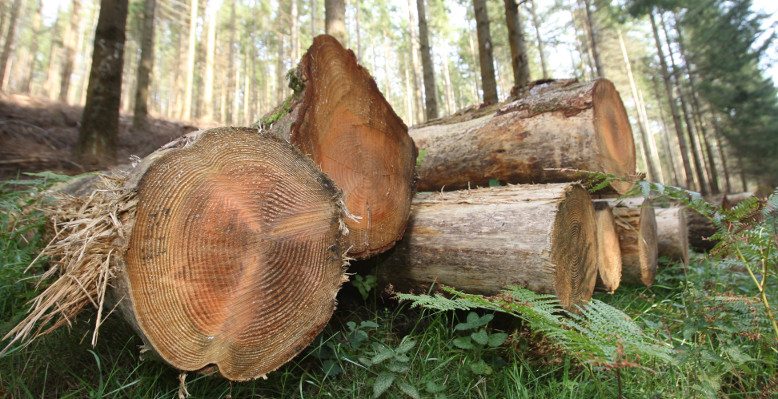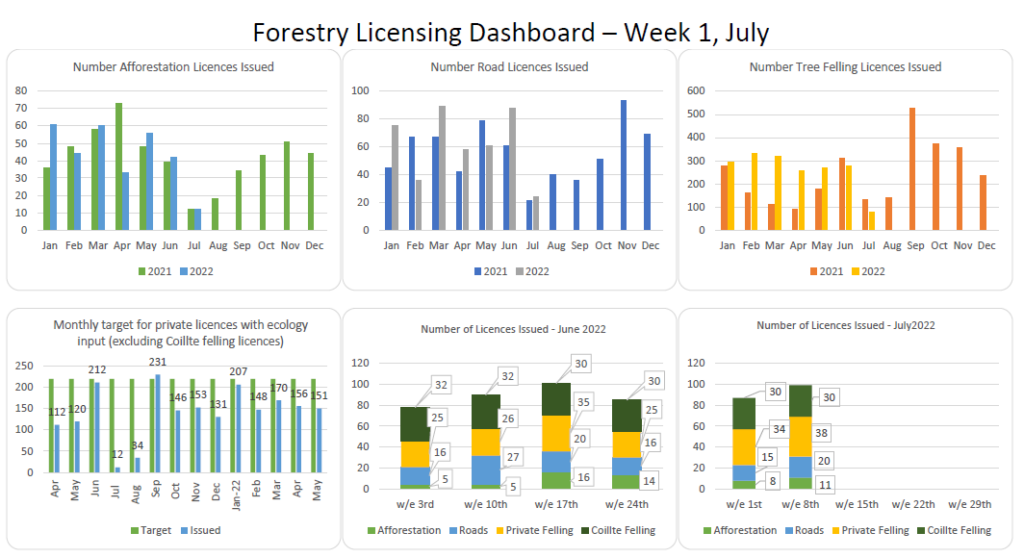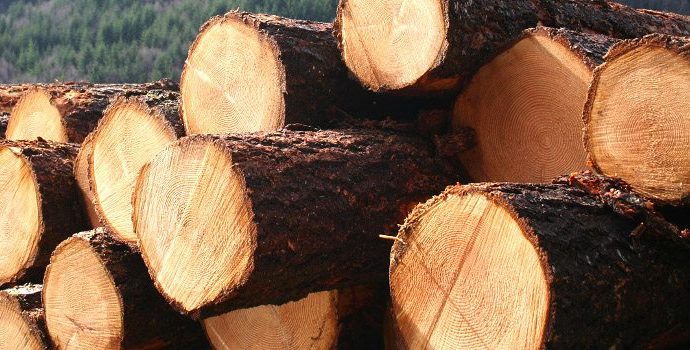Forestry Council Report July 2022

- Market Review
- IFA carried out a timber price survey for the period April – June 2022.
| Product Type | Length | Diameter | Price € /tonne |
| (m) | (cm) | (Roadside) | |
| Pulp | 3 m | < 7cm | 25-42 |
| Stakewood | 1.6 m | > 8cm < 15 cm | 34-44 |
| Palletwood | 2.5 m | > 14 cm | 38-48 |
| 3.1 m | 55-77 | ||
| 3.4 m | 62-78 | ||
| 3.7 m | 65-84 | ||
| Sawlog | 4.9m | > 20cm | 90-102 |
| 5.5 m | 100-115 | ||
Table 1. Roadside prices excluding VAT for Sitka spruce timber

Figure 1. Roadside pulpwood price trend

Figure 2. Roadside stakewood price trend

Figure 3. Roadside palletwood price trend

Figure 4. Roadside sawlog price trend
- The Department’s licence dashboard for June shows that a total of 354 forest licences issued, with is the equivalent to a weekly average of 89 licences.
- 230 licences issued to the private sector: 40 afforestation, 79 forest road and 111 felling licences.
- A total of 235 felling licences issued (111 issued to the private sector and 124 issued to Coillte). This means that approx. 47% of the felling licences issued to private forest sector in July

Figure 5: DAFM forestry licensing dashboard (Week 1, July)
- Activity since last National Council
- In June, the Project Woodland published the Regulatory Review Report. The report states that Ireland must have a consent regime. That an alternative regulatory framework, with statutory standards and conditions, would not meet the requirements of EU law.
- IFA attended several Project Woodland meetings in advance of publication of report to feed into the review process.
- The report makes 15 recommendations including that: mandatory ‘no go’ zones are adopted, AA/SEA screening distance of the 15km radius should be maintained, reasonable time-limits for decisions are introduced, more plan-led approach to licensing is adopted, identify ‘Go To’ areas for forestry, adopt standardised conditions and generally binding rules, calibrate the licensing system according to risk, thinning and road construction not to be exempted from the licencing system, do not adopt a single integrated licence for all forestry activities and adopt emergency response standards and plans (in the case of disease, windblow etc.).
- IFA issued press release following publication to stress disappointment with the review, particularly in relation to recommendation to not exempt thinning operations from the licencing process or to recommend single integrated licence system.
- IFA met with Mark Carlin, MD and Eamonn Kenny, Director of Forest Operations to discuss Coillte’s draft new Forestry Strategic Vision, which is designed capture of approx. 28 million tonnes of CO2 from by 2050. There was a detailed discussion on that target:
- To grow 100,000 hectares of new forests by 2050, supporting the delivery of one-third of Ireland’s afforestation target providing a carbon sink of 18 million tonnes of CO2.
- Redesign 30,000 hectares of peatland forests by 2050 through a programme of rewetting or rewilding.
- Promote the use of wood products to help increase the level of timber homes from 20% to 80% by 2050.
- Increase the area to be managed primarily for nature from 20% to 30% (an additional 44,000 hectares) by 2025.
- Transform and redesign an additional 70,000 hectares of existing forests, to create new semi-natural woodlands, providing valuable habitats, targeting that 50% of the estate is managed primarily for nature in the long-term.
The meeting was also used to discuss the ongoing issues in the sector particularly focussed on the (i) licence backlog and (ii) the Project Woodland regulatory review. The ongoing issues with forest roads were discussed.
- IFA meet with senior officials in the DAFM including Barry Delaney, Director of Forestry to discuss the new Forestry Programme. At the meeting IFA sought the following changes to the programme:
- The re-introduction of the farmer/non-farmer premium differential.
- The increase in the duration of the forest premium payments to 20 years for GPC 1 – 4 and to 35 years for GPC 5 -10.
- The increase in the duration of the Agro-Forestry (GPC 11) to 15 years.
- The increase in the premium payment rates to better reflect the opportunity cost of planting agricultural land.
- Forest premium rates should be linked to inflation and reviewed annually.
- The introduction of Payment for Ecosystem Services (PES) beyond the duration of the premium payment for land set aside for biodiversity enhancement to compensate farmers for the loss of earning potential on this land.
- The increase in the grant rates paid under the Afforestation and Woodland Creation, Forest Road and Woodland Improvement schemes to cover the significant rise in operational costs.
- The introduction of a Harvesting Plan grant to assist with the increasing costs associated with road and felling licence applications.
- The introduction of a Carbon Farming voluntary scheme.
- The introduction of Reconstitution scheme for forest owners affected by ash dieback.
- IFA met with Forestry Industry Ireland (FII) to discuss the need for reform in the forest sector, and to push for changes as part of the regulatory review as well as development of the new forestry strategy and programme. It was agreed to issue a joint press release (IFA, FII and ITGA) to start to restore farmers confidence in planting.
- IFA have written to Minister Darragh O’Brien seeking the introduction of a new scheme to support farmers to remove roadside diseased ash trees.
- The IFA Farm Forestry Management committee met on the 17th June and 4th July.
- Upcoming issues
- IFA will continue with campaign to ensure that new Forestry Strategy reflects the views of farmers and supports a forestry at farm level.
- Continued representation of farmers on Project Woodland.
- IFA Farm Forestry committee meeting will take place on 20th July where there will be an election for the position of Vice-Chair.


